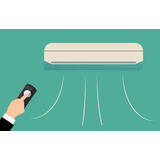It’s getting warm! Smart ways to reduce air conditioner costs
Author: Starts at 60 Date Posted:12 November 2019

Summer is creeping ever closer and with the warm weather already starting to kick in across the country, there’s no doubt that we’re in for a stifling few months. Whether you live in the south of the country where the dry heat leaves you burnt to a crisp, or in the north where the humidity makes you sweat up a storm, having some cool relief in the house is always appreciated.
But having that air conditioner pumping at all hours of the day and night could leave you out of pocket when your next bill rolls in. So how do you stay cool, while saving money? There are a few easy ways to feel comfortable in your own home without breaking the bank.
Switch to dry mode
Instead of automatically turning on the air conditioner to cool mode and letting the cold air breeze out, you can try using dry mode. You will find this setting on the remote of some – not all – air conditioners, with a symbol of a water droplet, while the cool mode is generally depicted with a snowflake.
Unlike cool mode which blows out refreshingly cold air, dry mode works by reducing the temperature in a room by lowering the humidity. As air in the room passes through the aircon, the water vapour condenses on the evaporator, acting like a dehumidifier.
While it’s not actively cooling the area, the reduction in humidity will make the room feel colder. This setting is particularly helpful for those living in the northern parts of Australia where humidity is present.
Set it at the right temperature
Setting your air conditioner to a chilly 18 degrees will certainly make the house feel like a freezer but it could be the reason for the sky-high bill. An air conditioner will use more electricity if it’s working harder, meaning the lower the temperature is, the more you are likely to pay.
According to consumer review and comparison website Canstar Blue, the standard air conditioner temperature should be set between 25 and 27 degrees for cooling in summer. But, Finder research revealed most Aussie households set the aircon to 22 degrees.
This is concerning given every degree of cooling increases your costs by around 10 per cent. However, that’s not the only problem, with Finder figures also revealing around 2.3 million households across the country are leaving their air conditioner on when nobody’s home, for an average of one hour per day. This adds up to a loss of around $200 million nationally, just because they want it cooler when they return home.
So, make sure to turn off those air-con units before heading out – it won’t take long for the room to cool down when you return.
Clean the air conditioner regularly
It sounds like a tedious task but cleaning out the air conditioner filter regularly will help it to pump out the cool air. Just like vacuum cleaners, dirt and dust can get clogged in the device, and prevent it from doing its job properly.
This usually results in you turning the temperature down, because you’re not feeling the room get cooler. And alas, the electricity bill sky-rockets.
Switch off appliances
While keeping all of your electronics plugged in and switched on makes things easier when you return home after a busy day out, you could unintentionally be making your house warmer than it needs to be. Electronic devices such as televisions and computers use plenty of power and often become very warm.
Whereas, cooking up a storm in the kitchen on a hot summer’s day is also probably not the best idea. Ovens and stove tops let off a lot of heat, which can quickly spread throughout the house.
While you shouldn’t completely avoid using these items, try and limit your usage or turn them on at times of the day that are the coolest, like early in the morning or late at night.
Keep the curtains and blinds closed
It’s probably something your parents told you to do as a child before heading off to school on a hot summer’s day, but keeping all the curtains and blinds closed will definitely keep the temperature down. Hanging them close to the window will prevent the sun from streaming through, while lighter coloured curtains and blinds will reflect the bright rays the most.



